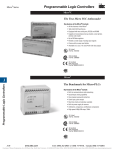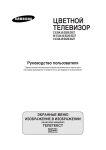Download Wells-Gardner D9100 Service manual
Transcript
Service Manual for D9100 Series Digital-Control Color Monitor Wells-Gardner Electronics 9500 W. 55th Street, Suite A McCook, IL 60525-3605 (708) 290-2100 069X3015-100 Revision: A / E01023 Date: 7-27-00 Printed on 02/11/04 INDEX 1. SAFETY PRECAUTION……………………………… 1 2. SPECIFICATION……………………………………… 2 3. TECHNCIAL FEATURES……………………………. 3 4. TIMING CHART………………………………………. 4 5. SET UP………………………………………………….. 6 6. CONTROLS AND ADJUSTMENT…………………... 7 7. ADJUSTMENT SPECIFICATION…………………… 10 8. DESCRIPTION OF CIRCUIT OPERATION………...13 9. TROUBLE SHOOTING……………………………….. 18 ii 1. SAFETY PRECAUTION: WARNING: Service should not be attempted by anyone unfamiliar with the necessary precautions on this unit. The following precautions are necessary during servicing. 1-1 Some parts, such as a picture tube in this unit, have special safety-related characteristics for X-RAY RADIATION protection. For continued safety, the parts replacement should be undertaken referring to below article (1-2 and 1-5). 1-2 Many electrical mechanical parts in this unit have special safety-related characteristics for protection against shock hazard and others. These characteristics are often passed unnoticed by visual inspection and the protection afforded by them cannot necessarily be obtained by using replacement components rated for higher voltage, wattage, etc. Replacement parts which have these special characteristics are identified in the manual and supplements by shading on the schematic diagram and the parts list. Before replacing any of these components, read the parts list in this manual carefully. 1-3 When replacing the chassis in the cabinet, always be certain that all the protective devices are installed properly, such as insulating covers, strain relief, etc. 1-4 Before replacing the back cover of the set, thoroughly inspect the inside of the cabinet to see that no stray parts or tools have been left inside. 1-5 Before returning the set to the customer, always perform an AC leakage current check on the exposed metallic parts of the cabinet, such as terminal, screwheads, metal overlays, control shafts, etc. To insure the set is safe to operate without danger of electrical shock, plug the AC line cord directly into a 120V AC outlet (do not use a line isolation transformer during this check). Use an AC voltmeter having 5000 ohms per volt or more sensitivity in the following manner. Connect a 1500 ohm, 10 watt resistor, parallel with a (0.15uF) capacitor. Reverse the AC plug in the AC outlet and repeat the AC voltage measurements for each exposed metallic part. Voltage measured must not exceed 0.3V RMS. This corresponds to 0.2mA AC, any value exceeding this limit constitutes a potential shock hazard and must be corrected immediately. 1 2. SPECIFICATION: 2-1.1 Picture Tube. • Size: 14”, 15”, 17”, 19”(18V) • Dot Pitch: 14” : 0.26 – 0.28mm 15” : 0.26 – 0.28mm 17” : 0.26 – 0.28mm 19” (18V): 0.25mm 2-1.2 Signal Input. • Video Input: Analog, Positive Signal (0.7V p-p) • Horizontal Sync: TTL Level, Positive or Negative Pulse • Scanning : 28 KHz-70KHz • Vertical Input: TTL Level, Positive or Negative pulse • Scanning : 40-160Hz 2-1.3 Power Supply. • Power Input : 120-240 VAC, 50/60Hz • Fuse Rating: 250V, 3.15A • Power Consumption 14inch : less than 70W 15inch : less than 80W 17inch : less than 95W 19inch : less than 110W 2-1.4 OSD (On Screen Display) Control: Refer to page 7 2-1.5 Operating Temperature: 0°C - 55°C 2-1.6 Operating Humidity: 10% - 90% (Noncondensing) 2-1.7 Net Weight 14inch : 22 lbs. (10kg) 15inch : 24 lbs. (11kg) 17inch : 33 lbs. (15kg) 19inch : 37 lbs. (17kg) 2 3. TECHNICAL FEATURES: 3.-1 Microprocessor control with OSD (On screen display menu). Microprocessor recognizes the input computer signal and signal output from the customer control board connected to the main board by a flat cable. 3-2 Universal AC Input Voltage. Power supply operates on 120-240 VAC at 60/50Hz for use all over the world. 3-3. Protection Circuit for over-current. When an over-current condition occurs in the circuit, the protection circuit operates in order to prevent the components from electrical shock or other risks. 3-4 Override function. A (NO SIGNAL MESSAGE) is displayed on the screen if no signal is present at the signal input cable while the monitor is powered on. 3-5 Control panel. If you require different display characteristics other than the factory mode presets of size, position, color settings, use the control panel to program it to your requirements in each resolution mode. These adjusted settings are kept in memory even if you change resolution mode or turn off the monitor. 3-6 I²C BUS control. The monitor is designed with I²C BUS control for simplifying the circuitry. The number of total components is less than 610 pcs. 3 4. TIMING CHART: Factory Pre-Set Timing Modes. Horizontal and Vertical Timing Diagram for Table 1. TABLE 1 : DESCRIPTION H V FH A B C D E POL. FV A B C D E POL. VIDEO MODE 1 VGA 720*400 31.469KHz 31.778µs 3.813µs 1.907µs 25.422µs 0.636µs NEGATIVE 70.087Hz 14.268ms 0.064ms 1.112ms 12.711ms 0.381ms POSITIVE ANALOG MODE 2 VGA 640*480 31.469KHz 31.778µs 3.813µs 1.589µs 25.422µs 0.318µs NEGATIVE 59.940Hz 16.683ms 0.064ms 0.794ms 15.253ms 0.064ms NEGATIVE ANALOG 4 MODE 3 8514/A 1024*768 35.552KHz 28.251µs 3.920µs 1.247µs 22.806µs 0.170µs POSITIVE 86.960Hz 11.500ms 0.113ms 0.563ms 10.810ms 0.014ms POSITIVE ANALOG MODE 4 S-VGA 680*480 37.500KHz 26.667µs 2.032µs 3.810µs 20.317µs 0.508µs NEGATIVE 75.000Hz 13.333ms 0.080ms 0.427ms 12.800ms 0.027ms NEGATIVE ANALOG TABLE 1 (CONTINUED) : DESCRIPTION H V FH A B C D E POL. FV A B C D E POL. VIDEO DESCRIPTION H V FH A B C D E POL. FV A B C D E POL. VIDEO MODE 5, S-VGA VESA 800*600 37.879KHz 26.400µs 3.200µs 2.200µs 20.000µs 1.000µs POSITIVE 60.317Hz 16.579ms 0.106ms 0.607ms 15.840ms 0.026ms POSITIVE ANALOG MODE 6 VGA 800*600 46.875KHz 21.333µs 1.616µs 3.232µs 16.162µs 0.323µs POSITIVE 75.000Hz 13.333ms 0.064ms 0.448ms 12.800ms 0.021ms POSITIVE ANALOG MODE 7 VGA VESA 800*600 48.077KHz 20.800µs 2.400µs 1.280µs 16.000µs 1.119µs POSITIVE 72.188Hz 13.853ms 0.125ms 0.478ms 12.480ms 0.722ms POSITIVE ANALOG MODE 8 VESA 1024*768 48.363KHz 20.677µs 2.231µs 1.615µs 15.754µs 0.998µs NEGATIVE 60.004Hz 16.666ms 0.124ms 0.600ms 15.880ms 0.062ms NEGATIVE ANALOG MODE 9 VESA 800*600 53.674KHz 18.631µs 1.138µs 2.702µs 14.222µs 0.569µs POSITIVE 85.062Hz 11.756ms 0.056ms 0.503ms 11.179ms 0.019ms POSITIVE ANALOG MODE 10 VESA 1024*768 56.476KHz 17.707µs 1.813µs 1.920µs 13.653µs 0.321µs NEGATIVE 70.069Hz 14.272ms 0.106ms 0.513ms 13.599ms 0.054ms NEGATIVE ANALOG MODE 11 VESA 1024*768 60.023KHz 16.660µs 1.219µs 2.235µs 13.003µs 0.203µs POSITIVE 75.029Hz 13.328ms 0.050ms 0.466ms 12.795ms 0.017ms POSITIVE ANALOG MODE 12 VESA 1280*1024 63.981KHz 15.698µs 1.037µs 2.296µs 11.852µs 0.360µs POSITIVE 60.020Hz 16.638ms 0.047ms 0.594ms 16.005ms 0.016ms POSITIVE ANALOG 5 MODE 13 VESA 1024*768 68.677KHz 14.561µs 1.016µs 2.201µs 10.836µs 0.508µs POSITIVE 84.997Hz 11.765ms 0.044ms 0.524ms 11.183ms 0.015ms POSITIVE ANALOG 5. SET UP: Setting up your monitor is easy. All you have to do is make a few simple connections and adjustments. The procedure is as follows: 5.1 Start Up. Your monitor starts up automatically when you insert the power plug to power source. 5-2. Single Cable Connection. Connect the 15pin signal cable to the source and lock both screws to ensure that the monitor is properly grounded. D type 15pin connector: PIN NO. 1 2 3 4 5 6 7 8 DESCRIPTION VIDEO RED VIDEO GREEN VIDEO BLUE N.C. N.C. VIDEO RED GROUND VIDEO GREEN GROUND VIDEO BLUE GROUND PIN NO. 9 10 11 12 13 14 15 6 DESCRIPTION N.C. GROUND N.C. SDA HOR-SYNC VER-SYNC SCL 6. CONTROLS AND ADJUSTMENTS: There are four switches on the control panel. Adjustable controls allow the best display status for individual requirements. 6-1. Key Function. ① MODE/EXIT MODE – Call the Main-Menu OSD ② SEL SEL – Call the Sub-Menu OSD ③ DOWN/UP When the Main-Menu is displayed, you can select each function using these keys. When the Sub-Menu is displayed, you can change the amplitude of the selected function of the screen using these keys. 6-2. O.S.D. CONTROL METHOD. User Adjustment. Location Adjustment Method CUSTOMER CONTROL PCB MAIN PCB Function Brightness Contrast Horizontal Position Horizontal Size Vertical Position Vertical Size Side Pincushion Trapezoid Pin Balance Parallelogram Sub-Bright H.V. Adjustment* Focus and Screen OSD CONTROL VR control, VR501 VR301 FBT *NOTE: (FACTORY ADJUSTED AND EPOXYED) 7 2. 3. 4. 5. 6. 7. 8. 9. 10. CONTRAST H. POSITION H. SIZE V. POSITION V. SIZE PINCUSHION TRAPEZOID PARRALLELOG PIN BALANCE ADJUST ADJUST ADJUST ADJUST ADJUST ADJUST ADJUST ADJUST ADJUST SAME ABOVE SAME ABOVE SAME ABOVE SAME ABOVE SAME ABOVE SAME ABOVE SAME ABOVE SAME ABOVE SAME ABOVE 8 6-3 OSD Controls (continued): 11. COLOR ADJUST 9 7. ADJUSTMENT SPECIFICATION: 7-1. Adjustment Sequence: The monitor requires a minimum of 15 minutes of warm up time before adjustment. 7-2. Adjustment Sequence: FBT B+ Voltage → G2 Voltage → Hor. Center → Hor. Size → Hor. Position → Ver. Size → Ver. Position → Side-pin → Trapezoid → Focus → White Balance → Convergence 7-3. Adjustment Procedure. How to enter the Factory Mode: Press Menu and Down simultaneously and hold down for three seconds. Adjust BRIGHTNESS and CONTRAST to “50” amplitude. 7-3.1 FBT B+ voltage adjustment. 1. Input the crosshatch pattern with the 31KHz 640*480 mode. 2. After connecting a digital voltmeter to D316, cathode and the frame ground, adjust FBT B+ voltage to 76V +/- 0.5V using VR301. 7-3.2 G2 Voltage adjustment. 1. Input the crosshatch pattern with 31 KHz 640*480 mode 2. After connecting a DC high voltage meter to the G2 of the CRT socket, adjust G2 voltage to 450 +/- 10V by changing SCREEN VR of FBT. 7-3.3 Geometry/Display Adjustment. Refer to controls and adjustment (Article 6) 7-3.4 Focus Adjustment 1. Input the “H” character pattern with 31 KHz 640*480 2. Adjust the focus for the best balance at each point of A,B,C,D,E as shown below by rotation the focus VR of FBT 3. For Dual Focus 17” monitors, adjust FOCUS 1 and FOCUS 2 for sharpest horizontal and vertical lines on a crosshatch pattern in oval area from point B to point C of display. Check overall focus in center and corners. 10 7-3.5 Pre-adjustment. 1. 2. 3. Warm up monitor for 15 minutes. Input the small window pattern with 31KHz 640*480 mode. Degauss the screen with Manual degaussing coil. 7-3.6 White Balance adjustment (background raster). 1. 2. Remove the video signal. Adjust the sub-brightness of background raster to be just out of cutoff (black) to be 0.7FtL +/- 0.2FtL with SUB BRIGHTNESS control VR501. 7-3.7 White Balance adjustment (video). 1. 2. 3. 4. 5. 6. 7. Input the window pattern with 31KHz 640*480 mode. Adjust the color temperature to be X=0.289+/-0.015 and Y=0.305+/-0.015 by R.G.B. gain on OSD COLOR GAIN Factory Sub Menu. Adjust step 2 until light output is 60FtL +/- 5FtL Adjust “CO” to 3FtL +/- 2FtL for next step Adjust the color temperature to be X=0.289+/-0.015 and Y=0.305 +/0.015 by R.G.B. bias control function on OSD Menu with the light output adjusted to 3 +/- 2FT/L. Go back to OSD COLOR GAIN Factory Sub Menu and reset “CO” to MAX before returning to Main Factory Menu. Exit Factory Menu by pressing “SEL” while in highlighted RESET position. 7-3.8 Purity and Convergence Adjustment. 1. Purity Adjustment. ① Demagnetize the picture tube and cabinet using a degaussing coil. ② Turn the CONTRAST and BRIGHTNESS controls to maximum. ③ Adjust RED and BLUE bias controls to provide only a green raster. ④ Loosen the clamp screw holding the yoke and slide the yoke backward to provide vertical green belt (zone) in the picture screen. ⑤ Remote the Rubber wedges ⑥ Rotate and spread the tabs of the purity magnet around the neck neck of the picture tube until the green belt is in the center of the screen. At the same time, center the raster vertically. Move the yoke slowly forward until a uniform green screen is obtained. Tighten the clamp screw of the yoke temporarily. 11 7-3.8 Purity and Convergence Adjustment (continued) ⑧ Check the purity of the red and blue raster by adjusting the bias controls. Obtain a white raster, referring to “CRT GRAY SCALE ADJUSTMENT” ⑩ Proceed with convergence adjustment. ⑨ 2. Convergence adjustment: ① Change to a crosshatch pattern with a color signal generator. ② Adjust the BRIGHTNESS and CONTRAST controls for well defined pattern. ③ Adjust two tabs of the 4-pole magnets to change the angle between them and superimpose red and blue vertical lines in the center of the picture screen. ④ Turn both tabs at the same time keeping their angles constant to superimpose red and blue horizontal lines at the center of the screen. ⑤ Adjust two tabs of 6-pole magnets to superimpose red/blue line with green one. Adjusting the angle affects the vertical lines and rotating both magnets affects the horizontal line. ⑥ Repeat adjustments 3,4 and 5, keeping in mind red, green and blue movement, because 4-pole magnets and 6-pole magnets interact and make dot movement complex. 12 1. DESCRIPTION OF CIRCUIT OPERATION: 8-1. Mode Control. 8-1.1 H-Sync is inputted to pin 30 of IC601, V-Sync to pin 29 of IC601 for each mode and pin 27, 26 of IC601 output always positive polarity sync. 8-1.2 The outputs from IC601 are as below (See table 1) No. Range of Frequency OUTPUT (MCU PIN) Frequency (CS3) (CS2) (CS1) OFF ST-BY SUS-P LED Hf Vf Resolution Hf (KHz) Vf (Hz) 38 39 40 5 3 4 6 KHz Hz 1 31 70 720x400 28 ~32.9 68 ~ 72 L L L L H L L 2 31 60 640X480 " 58 ~ 62 L L L L H L L 3 35 86 1024X768 33 ~ 35.9 84 ~ 88 H L L L H L L 4 38 75 640X480 36 ~ 40.9 73 ~ 77 H H L L H L L 5 38 60 800X600 36 ~ 40.9 58 ~ 62 H H L L H L L 6 47 75 800X600 41~ 51.9 73 ~ 77 H L H L H L L 7 48 72 800X600 " 70 ~ 74 H L H L H L L 8 48 60 1024X768 " 58 ~ 62 H L H L H L L 9 53 85 800X600 52 ~ 61.9 83 ~ 87 L H H L H L L 10 56 70 1024X768 " 68 ~ 72 L H H L H L L 11 60 75 1024X768 " 73 ~ 77 L H H L H L L 12 64 60 1280x1024 62 ~ 70 58 ~ 62 H H H L H L L 13 69 85 1024x768 62 ~ 70 83 ~ 87 H H H L H L L 13 8-2 Deflection Processor (IC301): 8-2.1 Horizontal section. 8-2.1.2 Horizontal Oscillation. Horizontal free frequency is set to 48KHz by R314 and C347. Autosync processing can be done from 28KHz to 70KHz by means of IC301 without any adjustment. 8-2.1.3 Phase Shift. Horizontal phase shift is controlled by IC601 using I²C BUS control. 8-2.1.4 Horizontal driver output. The output pulse which has the duty-cycle of 47% is available at pin 26 of IC301. The output is used by the horizontal drive circuit. 8-2.1.5 B+ control driver output. The output pulse is available at pin 6 of IC301 and it is used for the horizontal scan voltage control driver. 8-2.1.6 X-Ray protection. When the flyback voltage rises up to an unacceptable level, X-ray protection is activated. When the X-ray input pin 25 of IC301 is above 8V, the internal latch in IC301 is turned on. This stops all line drive output to the horizontal circuits. To reset the protection circuit, remove main power to the monitor for 5 seconds. 14 8-2.2 8-2.2.1 Vertical section: Vertical oscillation. The free running frequency of the vertical oscillator is determined by the capacitor C342 at pin VCAP (pin22) of IC301. 8-2.2.2 Vertical amplitude. Vertical amplitude is controlled by IC601 using I²C bus control. 8-2.2.3 Vertical position. Vertical position is controlled by IC601 using I²C bus control. 8-2.2.4 East-west parabola. A parabola wave-form is available on pin 24 of IC301 for driving the pincushion correction stage. Amplitude of parabola waveform is controlled by IC601 using I²C. 8-2.3 B+ Regulator. B+ PWM regulator output is available on pin 28 of IC301 for driving the B+ control stage. This PWM output is adjusted through VR301. 8.3 Vertical Deflection (IC201): IC201 (KA2142) is used for direct driving of the vertical deflection yoke. 8-4 Horizontal scan voltage control stage: The set-up converter is used in this stage. The output pulse at pin 28 of the IC301 is synchronized on horizontal frequency. This pulse is operated via buffer stage Q311/Q312. This output is rectified through D315/L304. In this way, the supply voltage to the flyback transformer can be proportional to the horizontal line frequency. 15 8-5 Horizontal deflection output stage: 8-5.1 Line driver stage. As a driver device, small MOSFET Q307(IRF630A) is used. The driver transformer T302 is equipped with a snubber circuit (R327/C309) at the primary side to damp excessive ringing. 8-5.2 Horizontal power output stage. The horizontal power output stage is a conventional one with a diode modulator. As a deflection transistor, the Q302 (KSC5802/3) is used. To compensate for horizontal linearity, T301 is connected in series with the horizontal DY. It is controlled by DC voltage of Q304 collector, which the base voltage of Q304 is integrated from output at pin 40 of IC601. 8-5.3 S-Correction capacitor switches. Q316 is off when horizontal frequency is 35KHz Q316, Q317 is off when horizontal frequency is 37KHz Q316, Q318 are off when horizontal frequency is 43KHz-52KHz Q317, Q318 is off when horizontal frequency is 53KHz ∼ 61KHz Q316, Q317, Q318 is off when horizontal frequency is 62KHz ∼70KHz Q316, Q318 is off when input is override condition 8-6 FBT (Flyback Transformer): The high voltage for CRT anode focus, G2 voltage for CRT and – 12V for vertical deflection are generated by the FBT. Also, -130V for G1 voltage, horizontal flyback pulse, +120V video supply, and for dual focus units 450V dynamic focus supply. 8-7 ABL (Automatic Beam Limiting): The voltage of point 7 depends on the anode current of FBT. So, the voltage at pin 7 of the FBT decreases with increasing anode current. That time, using at this level, increase contrast setting level limited a certain level (300µA in white pattern) that is set by inner voltage of IC401. 8-8 Video amplification section: 16 8-8.1. Video pre-amplifier(IC401). Input video signals are amplified by means of IC401, and the amplified signals drive the video output stage (IC402). Video gain is adjusted by DC voltage at pin 12 for ABL control. 8-8.2. Video output stage (IC402). The video output signals from IC401 are amplified again by IC402, and IC402 applies video signals to each cathode of the CRT. Cutoff voltages are adjusted by Q405, Q406, and Q407 which is operated by I²C BUS control through the microprocessor. 8-8.3. OSD (On Screen Display : IC403). The OSD signal is applied from IC403 to IC402. It is controlled by I²C BUS control line. 17 9.0 TROUBLESHOOTING 9.1 No Power 18 9-1. NO VIDEO: 19 9-2. NO RASTER: 20 9-4 TROUBLE IN HORIZONTAL SIZE: 21 9-5. TROUBLE IN CONTRAST: 22 9-6. TROUBLE IN BRIGHTNESS: 23



































